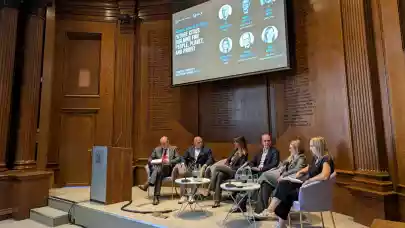
At the recent European Property Investment Update 2025, organised by Property Forum and RICS in London, the Future Cities panel brought together leading voices in real estate, sustainability, and urban planning to discuss the evolving landscape of European cities. Chaired by Joël Scherrenberg, Chair of the Dutch Advisory Board at RICS, the session delved into the challenges and opportunities facing cities as they strive to balance economic growth, environmental responsibility, and social well-being.
Hubert Abt, CEO of New Work & workcloud24, emphasised the necessity of profitability in sustainability measures. “We have shifted ESG away from being a marketing tool and now talk about sustainability and resilience because, in our experience, any sustainable measure must be profitable to be truly sustainable,” Abt explained. “If you cannot prove that a sustainability initiative pays into the cash flow and is profitable, then it simply won’t work in the long run. This is not about ticking boxes; it’s about embedding sustainability into the DNA of our business models.” He further elaborated on the importance of simulating each measure’s impact on future value, noting, “You need to convince the CFO by speaking their language—future value, not just operational expenses. Only then can you truly integrate sustainability into decision-making.”
Lucy Auden, Head of Sustainable Investments Programme at C40 Cities, brought a global perspective, focusing on the role of cities and municipalities in driving climate action. “We are seeing a remarkable shift in political leadership at the sub-national level, with mayors stepping up where national governments may be waning,” Auden observed. “At C40, we require our member cities to have robust plans aligned with 1.5-degree targets, and we hold them accountable. The willingness of cities to convene investors and the private sector is stronger than ever, and this collaboration is essential for urban regeneration and climate resilience.” She added, “If we don’t decarbonise cities, we simply won’t reach our sustainability goals, given the rapid pace of urbanisation.”
Aleksandra Njagulj, Managing Director and Global Head of ESG, Real Estate at DWS, addressed the practicalities and challenges of implementing ESG across different asset types. “Sustainability can bring measurable value, and no investor—regardless of their political stance—will turn down the opportunity to add value to their assets,” Njagulj stated. “The key is to move away from labels and focus on data and value creation. Even in urban development, the business case for sustainability is clear: locations that work attract investment, while those that don’t are left behind. Urban development with well-being in mind is absolutely going to bring value.”
Tamás Polster, Partner and Co-Founder of Urbanite Advisors, discussed the changing needs of occupiers and the importance of location and vibrancy in city planning. “We are seeing much more alignment between Europe and the US in how occupiers behave, with location and vibrancy being the primary drivers for return to office,” Polster explained. “Every morning, millions of people decide whether to go to the office, and the vibrancy of the surrounding area plays a crucial role in that decision. Before addressing the building itself, we must first address the location and the life experience it offers.”
Anna Sinnott, Director of Planning Consultancy at Be First Regeneration Limited, provided insights from the residential and social housing sectors. “Delivering new homes and regeneration in deprived areas is the most important driver for us, and partnerships with the private sector are becoming increasingly vital,” Sinnott shared. “There is a shift towards balancing environmental and social sustainability, especially as councils face borrowing constraints. The demand for energy-efficient homes is rising, and what was once seen as costly—like passive house standards—is now becoming the norm, even in the private sector.”
As the panel concluded, Scherrenberg reflected on the lessons from the past and the need for integrated, vibrant urban spaces. “If we want to understand the future, we have to know our past. Old cities thrived on mixed uses and proximity, and perhaps it’s time to bring that vibrancy back to our urban planning,” he said. The discussion underscored that the future of European cities will be shaped by collaboration, innovation, and a relentless focus on creating value for people, planet, and profit.



